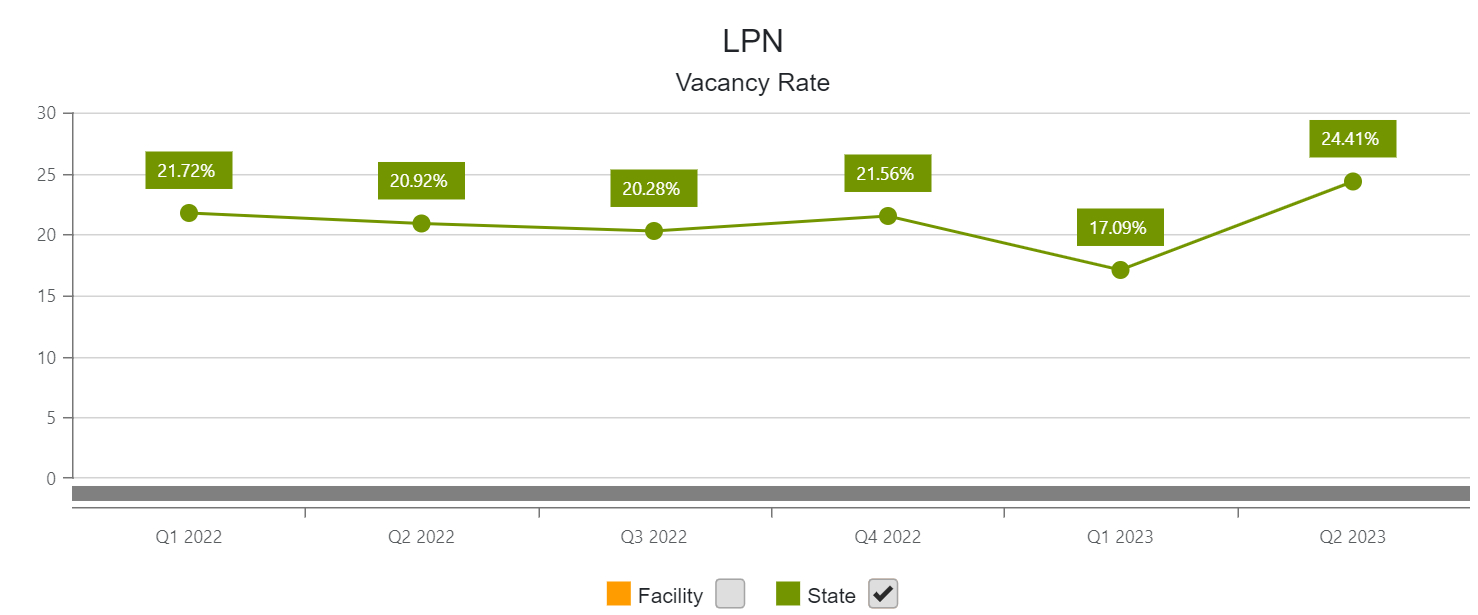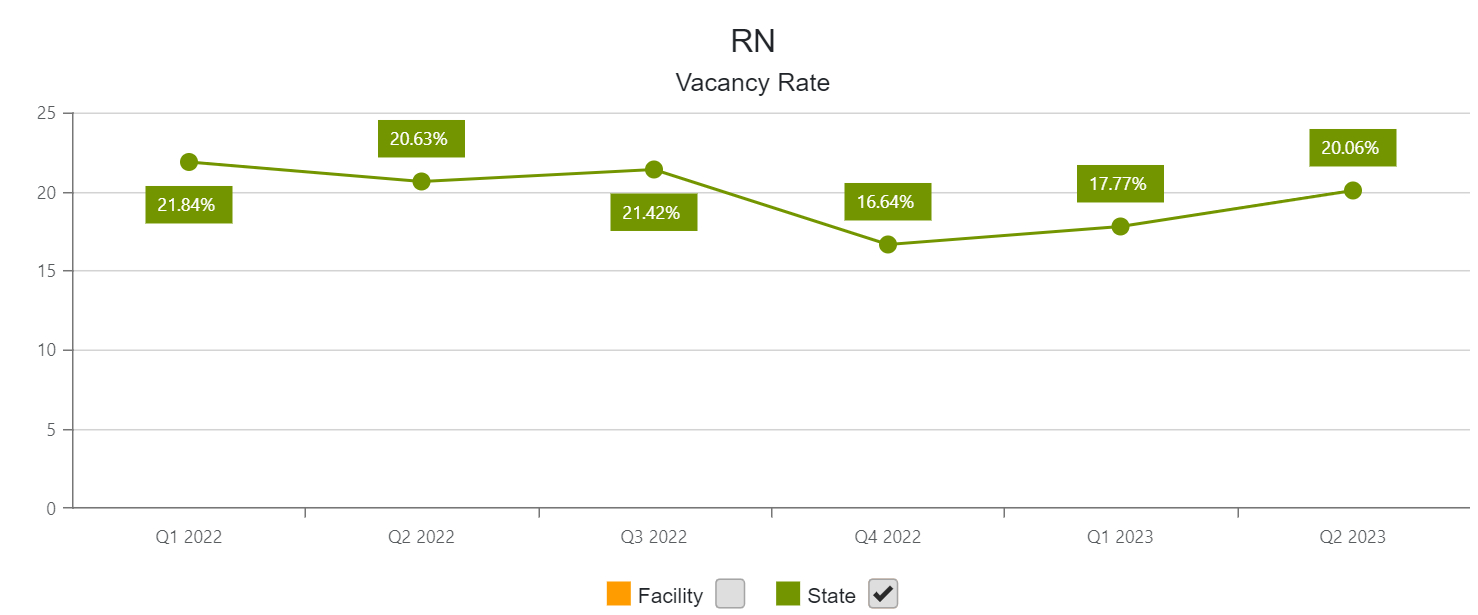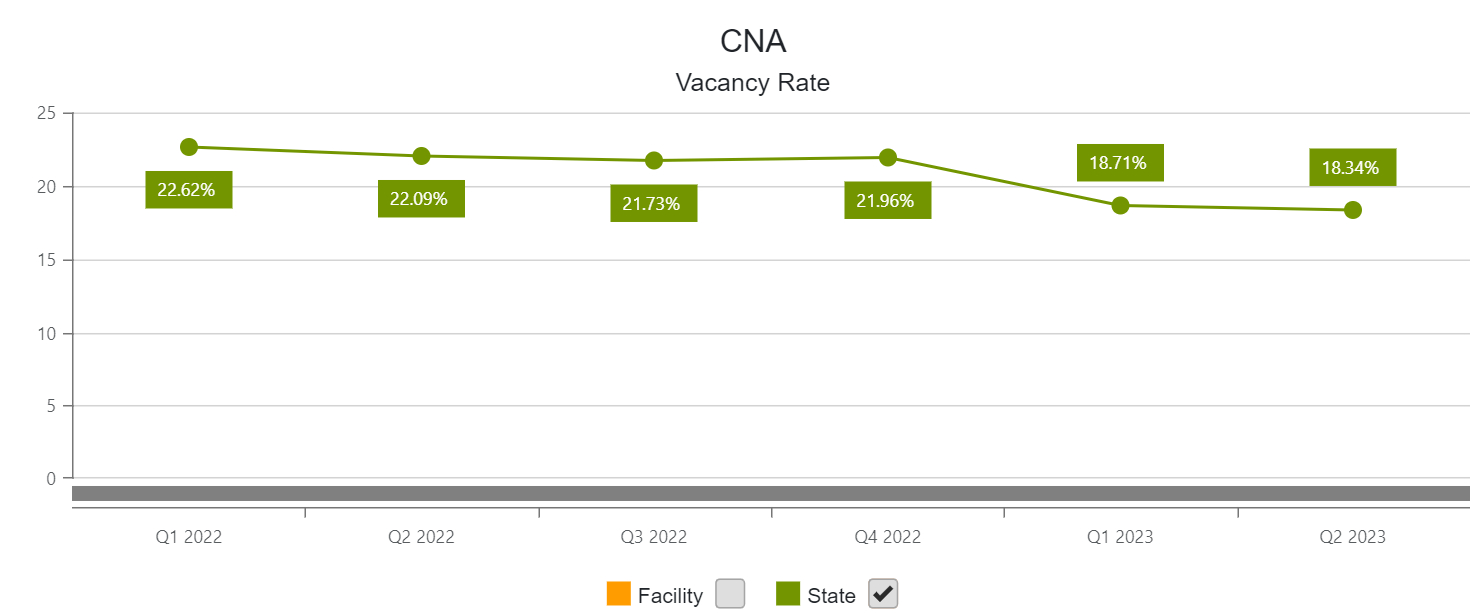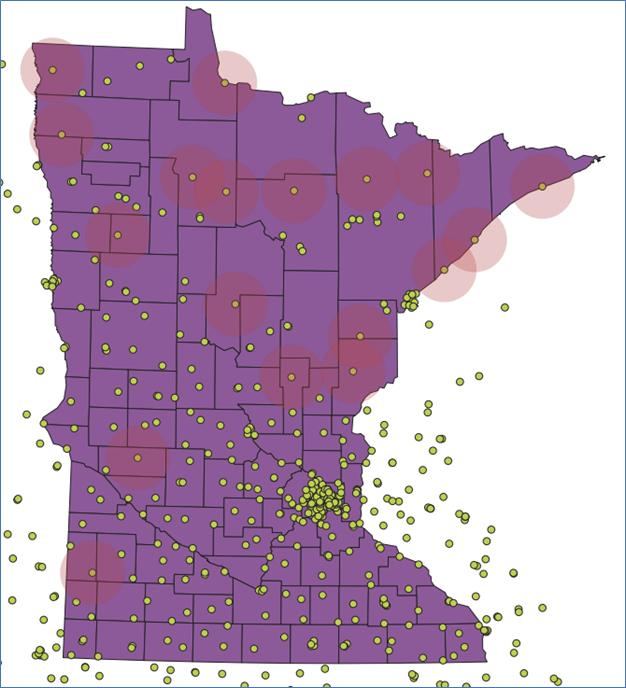Oct. 12, 2023
Featured News
Data Portal Shows Increases in Statewide Vacancy Rates for Licensed Nurses
On October 12, 2023 by Anna Mowry
Vacancy rates for registered and licensed practical nurses increased last quarter to over 20%, according to data submitted by members in the LeadingAge Minnesota Data Portal.
With over six quarters of workforce data compiled, the LeadingAge Minnesota Data Portal shows trends in statewide vacancy rates, turnover, and retention for critical positions in member settings. This past quarter, LPN vacancy rates spiked to 24.4%, while vacancy rates for RNs increased to 20%.


Dietary staff also saw an increase in vacancies this past quarter, however, trending with a lower statewide average vacancy rate of 12.8%. Meanwhile, nursing assistants (CNAs) vacancy rates have decreased over the past year and a half – dropping from 22.6% to 18.34%.

The application also includes data on medication aides (TMAs) from the past four quarters. Members can access more workforce trend reports and compare their data on employee vacancy rates, retention, and turnover metrics in the Workforce Application of the Data Portal.
Time to submit your third-quarter data
As more members enter their data each quarter, more and more insights can be discovered. Members should now submit third-quarter data for all LeadingAge Minnesota Data Portal applications.
What is the Data Portal?
How do you match up with your competitors? Do you want to know where your organization has opportunities to improve? The LeadingAge Minnesota Data Portal allows you access to data tracking and vital benchmarking to gain valuable insights and facilitate data-driven decisions.
Compare your performance with the following Data Portal Applications:
- Workforce: Employee turnover, retention, and vacancy metrics for RNs, LPNs, CNAs, TMAs, and dietary staff.
- Compensation: Wages, differentials, and bonuses for key staff positions, including DONs, RNs, CNAs, social workers, maintenance, and more.
- Financial conditions: Financial outlook of your organization, including operating margin, days cash on hand, debt coverage ratio, and reserves.
- Assisted living quality measures: Resident falls, medication errors, hospital/ED visits, capacity, and average length of stay metrics.
- Five-Star quality reports: Care center insights into your CMS 5-Star rating to focus your quality improvement efforts.
To learn more or for questions, please contact Julie Apold. To request data portal access, please contact Cari Kronschnable.
MDH to Pass Background Studies Cost to Providers
On October 12, 2023 by Erin Huppert
On Monday, the Minnesota Department of Health (MDH) convened a meeting with LeadingAge Minnesota and other provider o
rganizations to share that MDH-regulated healthcare providers will be responsible for paying the Department of Human Services (DHS) directly for all background studies initiated for current or prospective employees. This change will go into effect on Feb. 1, 2024, representing a significant cost shift to healthcare providers.
MDH issued a notice via GovDelivery on Wednesday, Oct. 11.
After our initial shock wore off, we successfully advocated for this change to go into effect on Feb. 1 instead of MDH’s initial targeted date of Jan. 1.
An additional month buys us a little more time to continue our advocacy and plan for this change, but it does not mitigate the devasting impact this will have on providers required to use background checks to ensure the safety of the people they serve. As a frame of reference, MDH shared that they’ve spent $1 million in under two months on background studies – costs that will now be placed on financially fragile healthcare providers across the continuum of care.
Impact on your organization
As of Feb. 1, providers will be responsible for paying the background study fee directly to DHS for each application submitted into NETStudy 2.0. Providers may also choose to have the study subject pay the fee.
The NETStudy 2.0 system will display a payment screen for background study applications submitted.
Providers will be responsible for paying the study initiation fee (currently $44 per initiated study) and the IDEMIA - IdentoGO vendor fee for live scan fingerprinting (currently $10.50 per study person).
Legislative appropriation for background studies
The legislature intended MDH to subsidize providers for background studies and provided MDH funding for this activity. For years, MDH and the Department of Human Services (DHS) have maintained an interagency agreement to transfer MDH funds provided by the legislature to DHS to subsidize or cover the ever-increasing costs of studies on behalf of providers.
MDH seems to have underestimated the cost of background studies to the legislature, leading to this dramatic and forthcoming change. However, this issue is more symptomatic of a broken background studies system than a lack of legislative funding—especially before the legislature can discuss or resolve this problem during the legislative session.
Next steps
While we have long worked with legislators to address underlying problems with Minnesota's background studies process, this development elevates the issue. We will continue our strong advocacy and use every tactic in our toolbox to stop this devasting decision from going into effect.
In the meantime, we ask you to assess the financial impact this change will have on your organization. Consider, in particular, the cost of initiating a study that is never completed because the applicant did not complete the fingerprinting requirement.
Other causes that might also result in the payment for initiating the background study but not resulting in completing the process include:
- Not completing the fingerprint and photo requirements within the 14-day timeframe;
- Not completing and submitting the consent and disclosure form required by NETStudy; or if the subject declines the consent and disclosure in error; or
- Withdrawing the request for a background study but later resubmitting a new background study application when a provider decides to hire a candidate.
Stay tuned for additional details and specific advocacy actions you can take to share the impact of this poorly-timed, short-sighted policy on your organization and your efforts to recruit a skilled, compassionate caregiving workforce.
Analysis of Proposed CMS Hours Per Resident Day Hardship Exemption Shows Only 18% May Qualify
On October 12, 2023 by Mark Schulz
All but 62 of Minnesota’s nursing homes would not be eligible for a hardship exemption to CMS’s hours per resident day requirement found in the proposed staffing standard rule. Only approximately 18% of providers would qualify.
A new analysis of the 3.0 hours per resident day (HPRD) hardship exemption location criteria shows that 62 facilities would qualify for one or both provider-population ratios or 20-mile geography factors. Qualification would permit the facility to continue assessing if it could meet the other criteria for the hardship exemption.
Exemption requirements
To request a hardship exemption under the proposed rule standard, nursing homes must meet three criteria and not be ineligible to receive an exemption. You can read more about these criteria details here.
Location criteria analysis
We analyzed the location criteria because it is the gateway to the exemption. A facility must meet one of the location criteria to continue with its eligibility for a hardship exemption. The two criteria are:
- Meeting either the registered nurse provider-population ratio or the nurse aide provider-population ratio
- Being more than 20 miles from another nursing home
If your nursing home doesn’t meet one of its two factors, you are not eligible for a hardship exemption to the 3.0 HPRD proposed standard requirement. The remaining hardship exemption criteria involve financial and other considerations and are facility-specific to operations and financial considerations outside the ability to be analyzed.
Analysis results
Based upon the proposed rule definitions, instructions on how to calculate provider-population ratios, and the linear distances between Minnesota facilities (and those within border states within 20 miles of the state borders), we have identified what we believe is the list of potential nursing facilities that might be eligible to receive a hardship exemption for the location criteria for the 3.0 HPRD proposed standard.
We have done our best to use the most recent and accurate information to develop these lists. If you are not on these lists, it is unlikely you would be eligible for any hardship exemption to the 3.0 HPRD proposed rule standard.
In summary:
- 13 (3.7%) nursing homes would qualify for the registered nurse provider-population ratio.
- 36 (10.5%) more would qualify for the nurse aide provider-population ratio.
- 13 (3.7%) additional nursing homes would qualify for the 20-mile geography factor.
Facilities that would meet the Location – Registered Nurse Provider-Population Ratio factor:
- Aicota Health Care Center
- Aitkin Health Services
- Bigfork Valley Communities
- Essentia Health Homestead
- Good Sam International Falls
- Grand Village
- Littlefork Medical Center
- Mn Veterans Home Silver Bay
- North Shore Health
- Sandstone Health Care Center
- St. Clare Lvg Comm of Mora
- The Emeralds at Grand Rapids
- The Waterview Shores LLC
Facilities that would meet the Location – Nurse Aide Provider-Population Ratio factor:
- Bay View Nursing & Rehab Center
- Divine Providence Community Home
- Good Sam Albert Lea
- Good Sam Society Comforcare
- Good Sam Society St James
- Koda Living Community
- Lake Winona Manor
- Lakeshore Rehabilitation Ctr
- Lakeview Methodist HCC
- Living Meadows at Luther
- Mayo Clinic Health System-Lake City
- Meadow Manor
- New Richland Care Center
- Northfield Care Center Inc
- Oak Hills Living Center
- Parkview Care Center Wells
- Pine Haven Care Center Inc
- Prairie Manor Care Center
- Sacred Heart Care Center Inc
- Saint Anne Extended Healthcare
- Sauer Health Care
- Seasons Healthcare
- Sleepy Eye Care Center
- St John's on Fountain Lake
- St. Crispin Living Community
- St. John Lutheran Home
- St. John's Lutheran Home
- St. Lukes Lutheran Care Center
- St. Mark's Living
- The Emeralds at Faribault LLC
- Thorne Crest Retirement Center
- Three Links Care Center
- Truman Senior Living
- Whispering Creek
- Whitewater Health Services
- Zumbrota Care Center
Facilities that would meet the Location – Geography (20-mile between facilities) factor:
[Note: Facilities with * next to the name also qualify for the Location exemption criteria for either the RN or NA Provider-to-Population Ratio. See the above lists to determine which one.]
- Avera Sunrise Manor
- Bigfork Valley Communities *
- Boundary Waters Care Center
- Cook Community Hospital C&Nc
- Good Samaritan Society - Blackduck
- Good Samaritan Society - Pine River
- Jourdain Perpich Ext Care Fac
- Kittson Memorial Healthcare Center
- Lakewood Care Center
- Mahnomen Health Center
- Meadow Lane Restorative Care Center
- Mille Lacs Health System
- Minnesota Veterans Home - Silver Bay *
- Moose Lake Village
- North Shore Health *
- North Star Manor
- Sandstone Health Care Center *
- The Waterview Shores LLC *
These facilities are also highlighted in the below image, indicated by a red, semi-transparent circle surrounding their address reflecting the 20-mile radius.

As a reminder, the HPRD hardship exemption is separate from the 24/7 registered nurse waiver request. That waiver process is already defined in current federal regulations at 42 CFR §483.35(f).
Oct. 3 Coaching Room
The Oct. 3 Coaching Room focused on learning about the federal system and process for submitting comments to federal rulemaking efforts. Our former colleague Jonathon Lips, Vice President of Legal Affairs with LeadingAge, provided this overview. You can view it here; use the passcode T.%j0jU@ to access it.
Action alert and congressional advocacy fly-in
Our members of Congress need to hear from us about the impact of this rule and what it will mean for Minnesota seniors across the state. Contact your members of Congress now.
LeadingAge Minnesota is planning a fly-in opportunity for care center leaders to meet with our delegation in Washington, DC, later this year to supplement Congressional visits while they are in Minnesota—details to come later this fall. If you want to learn more, please contact Erin Huppert at ehuppert@leadingagemn.org to be added to the communication list.
You can read the full proposed rule here.
Please reach out to:
- Mark Schulz with any questions, concerns, or comments regarding the proposed rule
- Erin Huppert, with any questions regarding the advocacy actions you can take
State News
Federal News
News from LeadingAge: HUD Posts Disaster Preparedness Plan Template
On October 12, 2023 by LeadingAge
HUD’s new Multifamily Disaster Preparedness Plan Template is designed to help HUD-assisted housing providers create property-specific plans to protect resident life and safety during a disaster.
The Department of Housing and Urban Development (HUD) released a Multifamily Disaster Preparedness Plan Template to help HUD-assisted multifamily owners and Public Housing Authorities (PHAs) produce property-specific plan(s) to protect resident life and safety during a disaster. The template draws upon best practices for disaster and evacuation planning and provides resources for users to learn more as they consider their property’s needs.
According to HUD, the template is designed to guide users through the process of gathering appropriate information and resident input, drafting a plan, and educating residents and staff about the plan. Multifamily owners and PHAs will be prompted to consider both the specific climate hazards faced by the property (based on the FEMA National Risk Index, historical hazards in the area, and other applicable sources of information) and resident needs. The plan includes worksheets for an evacuation plan that incorporates safe egress route(s), plans for evacuating residents with special needs, and clear communication of the evacuation plan and safety resources for residents.
The tool is organized under four essential elements to disaster planning:
- Background, Staffing, and Coordination
- Resident Protection and Safety
- Building Protection
- Business Continuity
Who Should Complete this Plan Template?
PHAs and other HUD-assisted multifamily owners in collaboration with staff and residents. While some HUD Multifamily-assistance programs require owners to have a disaster preparedness plan, it is a best practice for all multifamily properties to have a plan for disasters.
Notable News
Learn More about Select Rehabilitation, a LeadingAge Minnesota Solutions Partner
On October 12, 2023 by Stacy Rogers
Select Rehabilitation is LeadingAge Minnesota Solutions preferred therapy partner. Your partnership with them helps advance our outreach, advocacy, and education at LeadingAge Minnesota, in addition to the many benefits they bring to your community.
About Select Rehabilitation
Select Rehabilitation provides comprehensive physical, occupational, and speech therapy and wellness services to patients in thousands of sites nationwide.
- Their physical therapy services and programs are designed to address difficulties and decline with transfers, increase how far you can walk, and address new and increased pain and loss of balance when walking and during transfers.
- The occupational therapy programs can address the decline in abilities during grooming and dressing, increase in incontinent episodes of bladder, changes in vision, and difficulty engaging in leisure activities.
- Speech-language pathologists can help address problems with swallowing and chewing, trouble when expressing thoughts, and changes in communication and participation in activities.
LIFE Wellness Program
LIFE, their wellness program is designed for today’s assisted and independent living communities, includes:
- LifeMoves, a comprehensive and customized wellness program
- Dedicated therapy staff within your community,
- Technology such as VSTBalance to help reduce falls and Spiro100, which streams wellness classes
MDSAssist
MDSAssistTM, their optical scanning software, was specifically developed to support partners with timely and accurate MDS completion for success under PDPM. The software scans for over 37,000 ICD-10 codes and 1.4 million medical terms and highlights the location in the medical record where supportive documentation exists. Unstructured medical data (hospital records) is converted into appropriate ICD-10 codes and mapped appropriately to payment under PDPM.
SelectConnect
SelectConnectTM is an app that allows access to therapy progress and outcomes directly from the medical record.
Want to know more?
Contact:
- Trent Hermen at thermen@selectrehab.com to learn more about Select Rehabilitation
- Stacy Rogers at srogers@leadingagemn.org to learn more about LeadingAge Minnesota Solutions
Member News
LeadingAge Minnesota Education Solutions
Upload Assisted Living Quality Data to Data Portal through RTasks
On October 12, 2023 by Julie Apold
LeadingAge Minnesota has partnered with RTasks by ResiDex to coordinate assisted living quality measures.
The partnership allows RTasks customers who are also LeadingAge Minnesota members to collect data once through RTasks and have the data uploaded each quarter by RTasks to the LeadingAge Minnesota Data Portal.
If you are an RTasks customer and are interested in participating in this new opportunity to track and benchmark your data, reach out to RTasks Support.
Assisted living quality measures included in the partnership:
- Fall rates
- Fall with injury rates
- Medication error rates and types of errors
- Hospital/ED visit rates
- Capacity
- Average length of stay
- Payment source
What is the LeadingAge Minnesota Data Portal?
The LeadingAge Minnesota Data Portal allows you access to data tracking and vital benchmarking data to facilitate data-driven decisions. You can compare your performance against benchmarks for the following applications:
- Workforce – turnover, retention, and vacancy rates
- Assisted Living Quality Measures – falls, falls with injury, medication errors, hospital/ED visits, capacity, and ALOS
- Compensation – wages, differentials, and bonuses
- Financial Conditions – financial performance
LeadingAge Minnesota Data Portal Contacts
- To learn how you can get involved or for other questions, contact Jeff Bostic or Julie Apold
- For portal access, contact Cari Kronschnable
